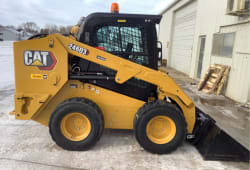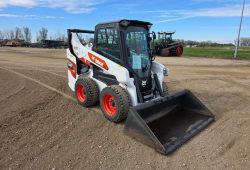A Complete Guide to Skid Steer Loaders
6 Lectura mínima
)
marzo 4, 2024
Skid steer loaders are compact, versatile machines that have become essential in numerous industries, including construction, agriculture, landscaping, and more. Their design enables them to navigate tight spaces and perform a variety of tasks efficiently.
History of Skid Steer Loaders
The concept of skid steer loaders was pioneered in the 1950s by the Melroe Manufacturing Company, which later became known as the Bobcat Company. These early machines were primarily used for agricultural purposes but quickly found applications in construction and other industries due to their adaptability.
Types of Skid Steer Loaders
Skid steer loaders come in two main types: wheeled and tracked. Wheeled skid steers are ideal for flat, stable surfaces, offering higher speeds and a smoother ride. Tracked skid steers, on the other hand, excel in rough terrain and soft ground, providing superior traction and stability.
Common Uses of Skid Steer Loaders
:format(webp))
Skid steer loaders are incredibly versatile machines, finding applications across a wide range of industries due to their adaptability and efficiency. Some of the most common uses of skid steer loaders include:
Construction
Skid steer loaders are indispensable on construction sites for tasks such as digging trenches, moving materials, grading land, and demolishing structures. Their compact size and maneuverability make them ideal for navigating tight spaces and working in confined areas.
Landscaping
Landscapers rely on skid steer loaders for various landscaping projects, including grading soil, laying sod, spreading mulch, and removing debris. Their ability to handle different attachments makes them versatile tools for shaping and maintaining outdoor spaces.
Agriculture
In agriculture, skid steer loaders are used for tasks such as loading and unloading feed, moving hay bales, cleaning livestock pens, and clearing brush. Their versatility makes them valuable assets on farms for tackling a wide range of chores efficiently.
Snow Removal
During the winter months, skid steer loaders equipped with snow removal attachments become essential for clearing driveways, parking lots, sidewalks, and other surfaces. Their agility and power enable them to maneuver through snow-covered areas with ease.
Material Handling
Skid steer loaders excel at material handling tasks, such as loading and unloading pallets, transporting supplies, and organizing inventory in warehouses and distribution centers. Their ability to maneuver in tight spaces enhances productivity in material handling operations.
Demolition
Skid steer loaders equipped with specialized attachments, such as hydraulic breakers or grapples, are used in demolition projects to break down structures, remove debris, and clear sites efficiently. Their compact size allows them to access confined spaces within buildings slated for demolition.
Utility Work
Skid steer loaders play a crucial role in utility maintenance and repair projects, such as digging trenches for laying pipes, excavating utility lines, and repairing roads and sidewalks. Their versatility and maneuverability enable utility workers to tackle various tasks effectively.
Event Setup and Cleanup
Skid steer loaders are often used for setting up and dismantling temporary structures, such as stages, tents, and fencing, for events such as concerts, festivals, and fairs. Their ability to navigate crowded spaces and transport heavy equipment makes them valuable assets for event organizers.
Municipal Services
Municipalities utilize skid steer loaders for maintaining parks, clearing trails, repairing infrastructure, and performing other public works tasks. Their versatility and efficiency make them indispensable for maintaining city and town facilities and amenities.
Forestry
In forestry operations, skid steer loaders are employed for tasks such as clearing brush, transporting logs, and maintaining forest trails. With the right attachments, they can also be used for tree planting and other reforestation efforts.
Skid steer loaders continue to be an essential tool across multiple industries, thanks to their versatility, maneuverability, and ability to perform a wide range of tasks with ease. Whether on construction sites, farms, or in municipal settings, these compact machines play a crucial role in getting the job done efficiently.
Advantages of Skid Steer Loaders
:format(webp)) One of the main advantages of skid steer loaders is their compact size, which allows them to access confined spaces that larger machinery cannot reach. Additionally, their zero-radius turning capability makes them highly maneuverable, enabling them to navigate around obstacles with ease.
One of the main advantages of skid steer loaders is their compact size, which allows them to access confined spaces that larger machinery cannot reach. Additionally, their zero-radius turning capability makes them highly maneuverable, enabling them to navigate around obstacles with ease.
Factors to Consider Before Buying a Skid Steer Loader
Several factors need to be taken into account before purchasing a skid steer loader. These include budget constraints, required size and power, available attachments for specific tasks, and the type of terrain the machine will be operating on.
Maintenance Tips for Skid Steer Loaders
Proper maintenance is crucial for ensuring the longevity and optimal performance of skid steer loaders. Regular inspections should be conducted to identify any potential issues, and lubrication of moving parts is essential to prevent wear and tear. Additionally, thorough cleaning after each use and prompt repairs of any damages are recommended.
Popular Skid Steer Brands
Numerous manufacturers produce skid steer loaders, each offering a range of models with varying features and capabilities. Some of the most renowned brands include Bobcat, Caterpillar, John Deere, Case, and New Holland.
Future Trends in Skid Steer Technology
The future of skid steer technology is focused on enhancing efficiency, productivity, and operator comfort. Advancements in automation, electrification, and telematics are expected to revolutionize the industry, providing operators with more intuitive and efficient machines.
Conclusion
Skid steer loaders play a vital role in various industries, thanks to their versatility, maneuverability, and efficiency. Whether used for construction, agriculture, landscaping, or other applications, these compact machines continue to evolve to meet the demands of modern work environments.
FAQs
1. What are the primary advantages of using a skid steer loader?
Skid steer loaders offer compact size, maneuverability, and versatility, making them suitable for a wide range of tasks and environments.
2. How do I choose the right skid steer loader for my needs?
Consider factors such as budget limitations, size and power requirements, available attachments, and the type of terrain the machine will be operating on to make an informed decision.
3. What maintenance is required for skid steer loaders?
Regular inspections, lubrication, cleaning, and prompt repairs of any issues are essential for maintaining skid steer loaders and ensuring optimal performance.
4. Which brands are known for producing quality skid steer loaders?
Some popular skid steer brands include Bobcat, Caterpillar, John Deere, Case, and New Holland, each offering a variety of models to suit different needs.
5. What are the future trends in skid steer technology?
Advancements in automation, electrification, and telematics are expected to shape the future of skid steer technology, improving efficiency, productivity, and operator comfort.

Post acquisition of Boom & Bucket, the company he founded, Adam now leads Marketplace Growth for Ritchie Bros.







